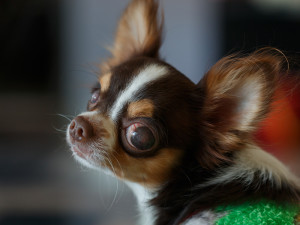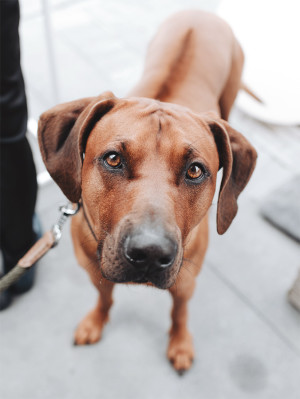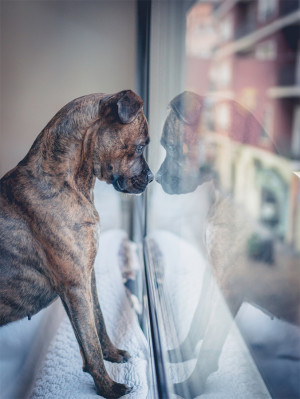Cloudy Eyes in Dogs: Causes, Risks, and How to Manage Vision Changes
There are a few possible reasons for your pup’s murky stare.

Share Article
In This Article:
How to Identify Cloudy Eyes in Dogs What Causes Cloudy Eyes? Breeds Prone to Cloudy Eyes How Are Cloudy Eyes Diagnosed? Treatment Options for Cloudy Eyes
Identifying cloudy eyes in a dog may seem obvious — Hey, that eye looks hazy! — but subtle differences in the type of cloudiness can provide clues about the cause. Read on for more information on what it means if you think your dog’s eyes are cloudy (and what you can do about it).
How to identify cloudy eyes in dogs
The primary areas of a dog’s eye that can appear cloudy include:
Cornea: The clear outer layer of the eye should appear transparent, allowing light to enter the eye. The cornea can appear hazy due to injury to its normally smooth surface or secondary to other problems within the eye.
Aqueous humor: The clear fluid in the front part of the eye helps the cornea maintain its rounded shape. Inflammatory cells in this fluid can make it reflect and refract light, giving it a cloudy appearance.
Lens: The lens sits just behind the colorful iris and focuses light that passes through the pupil onto the retina to create visionopens in new tab. The crystalline structure of the lens can become cloudy for many reasons, including aging changes, trauma, and metabolic disorders.
Symptoms
When considering cloudy eyes in dogs, symptoms commonly seen include:

Bluish or whitish surface color: This can look like a haze over the surface of the eyes. This appearance is commonly associated with corneal edema. When the inner or outer lining of the surface of the eye is disrupted, the fibers in the middle layer in the cornea become swollen, causing the cornea to lose its transparency. This can occur in a small spot around an injury or across the entire surface of the eye.
Aqueous flare: A dog’s eye can also appear cloudy in bright light due to inflammation in the front chamber of the eye. The cornea may remain clear, but cloudiness in the aqueous humor can make the iris and pupil appear hazy. This is often a subtle change that may not be obvious without specialized equipment, unless there is severe inflammation present. This front chamber can also have a buildup of white material due to pus within the eye or appear red due to bleeding inside the eye.
Cataracts: You may be familiar with cataracts because they are so common in people. If a dog has cataracts, the cornea and front chamber of the eye often remain clear, but the normally clear lens becomes visible through the pupil. This may appear as a slight cloudiness or a completely opaque white-to-yellow disc.
Redness or swelling: Cloudiness on the surface of or within the eye is often accompanied by other signs of inflammation. This can include a pink or reddish color to the whites of the eyes and swelling of the eyelids.
Squinting or blinking excessively: Many conditions that cause cloudy eyes in dogs also make their eyes painful and sensitive to light. Narrowing of the eyes is a common sign of ocular discomfort in dogs.
Pawing at the eyes: Another sign of eye pain in dogs is pawing at the eyes. Dogs will rub their eyes just like we do, either by pawing at them or squishing the side of their face into things. This may give them some relief by putting pressure on a painful area and removing discharge, but it can also result in trauma to the delicate surface of the cornea.
Difficulty seeing in dim lightopens in new tab: This can be a subtle change, but many eye problems will cause a dog’s pupils to spasm and constrict, resulting in a pinpoint pupil. Dogs aren’t able to see much when the pupil isn’t able to open fully in low-light situations.
What causes cloudy eyes?
Non-serious causes
Nuclear sclerosis: Cloudy eyes in older dogs are often due to this age-related change within the lens. Nuclear sclerosis is pretty much the only cause of cloudiness in a dog’s eyes that isn’t an immediate concern. It occurs due to increased density within the center of the lens as the body continues to produce lens fibers. Even though dogs with nuclear sclerosis don’t show significant vision deficits, this cause of haziness should still be checked out by your veterinarian because it can look very similar to cataracts.
Serious causes
Corneal Ulcers or Injuries: Any disruption of the super-smooth surface of the cornea can cause corneal edema and a cloudy appearance to the eye. This includes abrasions due to trauma or debris, burns due to chemicals (like shampoos or disinfectants), and ulcers associated with dry eyeopens in new tab. In a dog, eye infections don’t usually occur spontaneously, but any type of corneal lesion sets the stage for infection. If a corneal injury becomes infected, it worsens the initial insult and causes increased inflammation and haziness.
Uveitis: Uveitis describes inflammation within the eye, generally originating from the vascular surface of the iris, ciliary body (which controls the pupil and produces the fluid that fills the eye), or choroid (which covers the inner surface of the back half of the eye). Uveitis can occur due to blunt or sharp trauma to the eye, cancer, lens disorders, or systemic diseases like ehrlichiosis or toxoplasmosis.
Glaucoma: Glaucoma is an increase in pressure within the eye. The excess pressure damages structures within the eye and can lead to blindness. This damage can lead to cloudiness by causing corneal edema or cataracts as the disease progresses. Glaucoma can be a primary, breed-related disease or occur secondary to uveitis or other ocular issues.
Cataracts: The development of cataracts may be linked to a genetic disorder in some breeds or occur secondary to another disease process like diabetes mellitus. Cataracts progress from incipient (often asymptomatic) to immature (may begin affecting vision) to mature (causing blindness) to hypermature (lens begins leaking and shrinking). These progressive changes to the lens can result in other ocular problems like uveitis and glaucoma.
Breeds prone to cloudy eyes
Dog breeds prone to eye issues can develop cloudy eyes, and almost every breed has the potential for at least one eye disorder. Flat-faced dogs are prone to corneal ulcers, breeds prone to allergies are more likely to have conjunctivitis, and over 150 breeds are at risk for inherited cataract development. Some breeds that are most likely to develop eye problems include:
English and French Bulldogs
American Cocker Spaniels
Boston Terriers
Poodles
Labrador Retrievers
Basset Hounds
Shar Pei
How are cloudy eyes diagnosed?
Diagnosing the reason for a dog’s cloudy eyes goes beyond locating the source of the cloudiness. Some causes can be found on a basic examination, while others require a significant workup. Some common diagnostic procedures your vet can perform to determine the cause of cloudy eyes include:
Physical examination: A whole-body physical examination helps to find any other concurrent conditions that may be affecting the eyes. A more detailed examination for ocular issues starts with looking around the eyes to see if the problem could be caused by anatomical abnormalities like inwardly rolled eyelids or eyelashes that are contacting the eyes.
Ocular examination: Using a magnifying lens and a light source, your vet can look in more detail at the structures on the surface of and within your dog’s eyes. This helps to localize and determine the severity of the cloudiness.
Tonometry: Checking the intraocular pressure can help to give information about problems like uveitis and glaucoma.
Eye staining: A special fluorescent dye is used to determine if the surface of the cornea has been disrupted.
Tear production: A Schirmer tear test looks at the volume of tears produced in a certain time period. Low tear production is a common cause of corneal ulcers and scarring of the eye’s surface.
Blood and urine tests: Eye problems can appear secondary to systemic diseases like diabetes mellitus, kidney disease, or infectious diseases. Testing for these problems often starts with lab work.
Treatment options for cloudy eyes
Diagnosing the underlying cause of the ocular problem is the key to knowing how to treat cloudy eyes in dogs. Treatments can vary from short-term and simple to life-long and complex. Some common treatments include:
Veterinary treatments
Antibiotics and anti-inflammatories: These are the mainstays for many acute eye issues. Topical medications are often used for uncomplicated corneal ulcers, while systemic medications may be needed for deep ulcers or uveitis.
Surgery: Surgical options for dog eyes have advanced significantly in the past couple of decades, and veterinary ophthalmologists can perform many procedures to help preserve vision in dogs. These include cataract removal, lens replacement, cherry eye repair, and corneal grafts.
Glaucoma-specific medications: Managing glaucoma can be a complex undertaking. Topical and oral medications are given to limit pressure within the eye and control pain.
Home remedies
Once the cause of your dog’s cloudy eye has been diagnosed, your veterinarian may have some suggestions for ongoing care to prevent the recurrence of issues that could cause cloudy eyes. These may include things like:
Artificial tears or lubricating eye drops: Your vet may recommend specific over-the-counter eye drops for your dog if they have dry-eye syndrome. These will help to keep your dog’s eyes lubricated, reducing the risk of corneal injury and scarring.
Regular grooming: Long-haired dogs can have issues with eye irritation due to buildup of discharge at the corners of their eyes or due to stray hairs rubbing against their eyes. Keeping their face properly groomed can help to prevent eye problems in fluffier breeds.
Eye wash: You can talk to your vet about keeping some eye wash appropriate for dogs at home if your dog is one that likes to stick their face into everything. Dogs that participate in activities with a high risk for getting debris in their eyes (like playing in high grass or sand) may benefit from having their eyes flushed at the first sign of irritation.
Final thoughts
Cloudy eyes in dogs may signal conditions ranging from harmless aging processes like nuclear sclerosis to severe issues like glaucoma or cataracts. Identifying the underlying cause is crucial for proper treatment. Consult a veterinarian promptly if your dog’s eyes appear cloudy or their vision seems affected.
References
Bobofchak, Mark. “Managing diseases of the lens-clarification of a cloudy type.” DVM360, May 2011. https://www.dvm360.com/view/managing-diseases-lens-clarification-cloudy-type-proceedingsopens in new tab
Clode, Alison. “Differentiating Nuclear Sclerosis From Cataracts.” Clinician’s Brief. https://www.cliniciansbrief.com/article/differentiating-nuclear-sclerosis-cataractsopens in new tab
Gelatt, Kirk N, and Edward O MacKay. “Prevalence of the breed-related glaucomas in pure-bred dogs in North America.” Veterinary ophthalmology vol. 7,2 (2004): 97-111. doi:10.1111/j.1463-5224.2004.04006.xopens in new tab
Glaze, Mary B. “Ophthalmic Problem Solving: The Cloudy Eye.” Proceedings of the Western Veterinary Conference, Feb 2013.

Dr. Bartley Harrison, DVM
Dr. Bartley Harrison is a veterinarian with more than 19 years of experience. He has treated a variety of species in emergency and speciality practices for both large and small animals. His primary interests as a vet are emergency medicine and critical care.
Related articles
![a puppy sleeping with their eyes open]()
Can Dogs Sleep With Their Eyes Open?
Dogs: They’re not just like us.
![close up of Chihuahua dog's eye with cataracts]()
Common Eye Problems in Dogs and How to Treat Them
Your dog sees you as their best friend, so keep those eyes healthy.
![Sweet young brown labrador with brown eyes on a leash.]()
Why Do Most Dogs Have Brown Eyes?
Someone cue “Brown Eyed [Dog].”
Why Does My Dog Have Eye Boogers?
Next question: Will they let you anywhere near their eyes to wipe off that gunk?
![a dog walking with their parent at night]()
Why Do Dogs’ Eyes Glow in the Dark?
The reason for your midnight jump-scare? Turns out it’s just your dog’s spooky eyes.
![Dog Looking Out The Window.]()
Dog Vision: What Do Dogs See?
Those soulful eyes mean everything to you—learn all about them.





